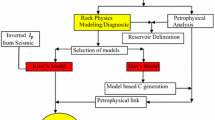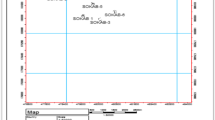Abstract
Rock physics provides a link between seismic and reservoir properties. It helps to understand the effects of fluid substitution and reservoir parameters on seismic signatures. Rock physics models are now an integral part of feasibility study of time lapse (4D) seismic surveys and their interpretation. There exist different approaches for the construction of rock physics models within the context of 4D seismic study. The objective of this study is to investigate the predictions of existing rock physics models for time lapse seismic studies using real well data. The pore-filled fluid properties used represent the in situ conditions, while the effective elastic moduli and bulk densities are calculated based on theoretical models. Finally the reflection and amplitude predictions from each model are compared over a range of water saturation. Our results suggest that only Krief’ s model is able to discriminate between porous and non-porous zones effectively. Furthermore, all of the investigated models show increase in velocity with replacement of oil with heavier fluid i.e., water except Wyllie’s model. There is a significant change in seismic amplitude when compared with in situ conditions for this particular lithology.
Similar content being viewed by others
References
Adam, L., Batzle, M., and Brevik, I., 2006, Gassmann’s fluid substitution and shear modulus variability in carbonates at laboratory seismic and ultrasonic frequencies. Geophysics, 71, F173–F183.
Akhter, G., Ahmed, Z., Ishaq, A., and Ali, A., 2014, Integrated interpretation with Gassmann fluid substitution for optimum field development of Sanghar area, Pakistan: a case study. Arabian Journal of Geosciences, 8, 7467–7497.
Artola, F.A. and Alvarado, V., 2006, Sensitivity analysis of Gassmann’s fluid substitution equations: Some implications in feasibility studies of time-lapse seismic reservoir monitoring. Journal of applied geophysics, 59, 47–62.
Avseth, P., Mukerji, T., and Mavko, G., 2005, Quantitative seismic interpretation: Applying rock physics tools to reduce interpretation risk (2nd edition). Cambridge University Press, Cambridge, 376 p.
Banks, C.J. and Warburton, J., 1986, Passive-roof duplex geometry in the frontal structures of the Kirthar and Sulaiman mountain belts, Pakistan. Journal of Structural Geology, 8, 229–237.
Batzle, M. and Wang, Z., 1992, Seismic properties of pore fluids. Geophysics, 57, 1396–1408.
Benson, S.M. and Cole, D.R., 2008, CO2 sequestration in deep sedimentary formations. Elements, 4, 325–331.
Biondi, B., Mavko, G., Mukerji, T., Rickett, J., Lumley, D., Deutsch, C., Gundeso, R., and Thiele, M., 1998, Reservoir monitoring: a multidisciplinary feasibility study. The Leading Edge, 17, 1404–1414.
Biot, M.A., 1941, General theory of three-dimensional consolidation. Journal of Applied Physics, 12, 155–164.
Biot, M.A., 1956, Theory of propagation of elastic waves in a fluid-saturated porous solid. I. Low-frequency range. The Journal of the Acoustical Society of America, 28, 168–178.
Blonk, B., Calvert, R.W., Koster, J.K., and van der Zee, G., 1998, Assessing the feasibility of a 4D seismic reservoir monitoring project. Proceedings of European Petroleum Conference of the Society of Petroleum Engineers, Hague, Oct. 20–22, p. 307–314.
Castagna, J.P., Batzle, M.L., and Eastwood, R.L., 1985, Relationships between compressional-wave and shear-wave velocities in clastic silicate rocks. Geophysics, 50, 571–581.
Duffy, J. and Mindlin, R., 1957, Stress-strain relations and vibrations of a granular medium. Journal of Applied Mechanics, 24, 585–593.
Gassmann, F., 1951, Uber die Elastizität poröser median. Vierteljahrsschrift der Naturforschenden Gesellschaft in Zürich, 96, 1–23.
Geertsma, J. and Smit, D.C., 1961, Some aspects of elastic wave propagation in fluid-saturated porous solids. Geophysics, 26, 169–181.
Goldberg, I. and Gurevich, B., 1998, A semi-empirical velocity-porosityclay model for petrophysical interpretation of P- and S-velocities. Geophysical Prospecting, 46, 271–285.
Guéguen, Y., 1994, Introduction to the Physics of Rocks. Princeton University Press, Princeton, 294 p.
Han, D. and Batzle, M.L., 2004, Gassmann’s equation and fluid-saturation effects on seismic velocities. Geophysics 69, 398–405.
Han, D.H., Nur, A., and Morgan, D., 1986, Effects of porosity and clay content on wave velocities in sandstones. Geophysics, 51, 2093–2107.
Hashin, Z. and Shtrikman, S., 1963, A variational approach to the theory of the elastic behaviour of multiphase materials. Journal of the Mechanics and Physics of Solids, 11, 127–140.
Hill, R., 1952, The elastic behaviour of a crystalline aggregate. Proceedings of the Physical Society. Section A, 65, 349–354.
Johnston, D.H., 2013, Practical applications of time-lapse seismic data. Distinguished Instructor Series No. 16, Society of Exploration Geophysicists, 270 p.
Jones, T. and Nur, A., 1983, Velocity and attenuation in sandstone at elevated temperatures and pressure. Geophysical Research Letters, 10, 140–143.
Kadri, I.B., 1995, Petroleum Geology of Pakistan. Pakistan Petroleum Limited, Karachi, 275 p.
Kazemeini, S.H., Juhlin, C., and Fomel, S., 2010, Monitoring CO2 response on surface seismic data; a rock physics and seismic modelling feasibility study at the CO2 sequestration site, Ketzin, Germany. Journal of Applied Geophysics, 71, 109–124.
Krief, M.J., Garat, J., Stellingwerff, J., and Ventre, J., 1990, A petrophysical interpretation using the velocities of P and S waves (full waveform sonic). The Log Analyst, 58, 355–369.
Kumar, D., 2006, A tutorial on Gassmann fluid substitution: formulation, algorithm and Matlab code. Geohorizons, 4, 4–12.
Landrø, M., 2006, Future challenges and unexplored methods for 4D seismic analysis. Canadian Society of Exploration Geophysicists (CSEG), 31, 128–135.
Li, S., 2009, Characteristics of fluid substitution in porous rocks. Petroleum Science, 6, 139–145.
Lumley, D., 2001, Time-lapse seismic reservoir monitoring. Geophysics, 66, 50–53.
Mavko, G., Chan, C., and Mukerji, T., 1995. Fluid substitution: Estimating changes in Vp without knowing Vs. Geophysics, 60, 1750–1755.
Mavko, G., Mukerji, T., and Dvorkin, J., 2009, The Rock Physics Handbook: Tools for Seismic Analysis of Porous Media. Cambridge University Press, Cambridge, 511 p.
Mezghani, M., Fornel, A., Langlais, V., and Lucet, N., 2004, History matching and quantitative use of 4D seismic data for an improved reservoir characterization. Annual Technical Conference and Exhibition of Society of Petroleum Engineers, Houston, Sep. 26–29. http://dx.doi.org/10.2118/90420-MS
Misaghi, A., Negahban, S., Landr, M., and Javaherian, A., 2010, A comparison of rock physics models for fluid substitution in carbonate rocks. Exploration Geophysics, 41, 146–154.
Murphy, W.F., 1982, Effects of microstructure and pore fluid on the acoustic properties of granular sedimentary materials. Ph.D. thesis, Stanford University, Stanford, 255 p.
Nguyen, P.K. and Nam, M.J., 2011, A review on methods for constructing rock physics model of saturated reservoir rock for time-lapse seismic. Geosystem Engineering 14, 95–107.
de Paula, O.B., Pervukhina, M., and Gurevich, B., 2010, Testing Gassmann fluid substitution in carbonates: sonic log versus ultrasonic core measurements. 80th Annual International Meeting of Society of Exploration and Geophysics (Expanded Abstract), Denver, Oct. 17–22, p. 2670–2674.
Saleh, A. and Castagna, J., 2004, Revisiting the Wyllie time average equation in the case of near spherical pores. Geophysics, 69, 45–55.
Sengupta, M., Mavko, G., and Mukerji, T., 2003, Quantifying sub resolution saturation scales from time-lapse seismic data: A reservoir monitoring case study. Geophysics, 68, 803–814.
Simm, R., 2007, Practical Gassmann fluid substitution in sand/shale sequences. First Break, 25, 61–68.
Smith, T.M., Sondergeld, C.H, and Rai, C.S., 2003, Gassmann fluid substitutions: A tutorial. Geophysics, 51, 430–440.
Tsuneyama, F. and Mavko, G., 2007, Quantitative detection of fluid distribution using time-lapse seismic. Geophysical Prospecting, 55, 169–184.
Varela, O.J., Torres-Verdn, C., Sen, M.K., and Roy, I.G., 2006, Using time-lapse seismic amplitude data to detect variations of pore pressure and fluid saturation due to oil displacement by water: a numerical study based on one-dimensional prestack inversion. Journal of Geophysics and Engineering, 3, 177–193.
Wang, Z., 2001, Fundamentals of seismic rock physics. Geophysics, 66, 398–412.
Watts, G., Jizba, D., Gawith, D., and Gutteridge, P., 1996, Reservoir monitoring of the Magnus field through 4D time-lapse seismic analysis. Petroleum Geoscience, 4, 361–372.
Wood, A.W., 1955, A Textbook of Sound. McMillan Co., New York, 610 p.
Wyllie, M., Gregory, A., and Gardner, L., 1956, Elastic wave velocities in heterogeneous and porous media. Geophysics, 21, 41–70.
Wyllie, M., Gregory, A., and Gardner, G., 1958, An experimental investigation of factors affecting elastic wave velocities in porous media. Geophysics, 23, 459–493.
Zaigham, N.A. and K.A. Mallick., 2000, Prospect of hydrocarbon associated with fossil-rift structures of the southern Indus basin, Pakistan. American Association of Petroleum Geologists Bulletin, 84, 1833–1848.
Zhu, X. and McMechan, G.A., 1990, Direct estimation of the bulk modulus of the frame in a fluid saturated elastic medium by Biot’s theory. 60th Annual International Meeting of Society of Exploration and Geophysics (Expanded Abstract), San Francisco, Sep. 23–27, p. 787–790.
Author information
Authors and Affiliations
Corresponding author
Rights and permissions
About this article
Cite this article
Toqeer, M., Ali, A. Rock physics modelling in reservoirs within the context of time lapse seismic using well log data. Geosci J 21, 111–122 (2017). https://doi.org/10.1007/s12303-016-0041-x
Received:
Accepted:
Published:
Issue Date:
DOI: https://doi.org/10.1007/s12303-016-0041-x




